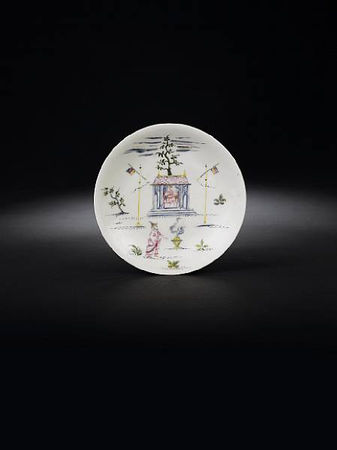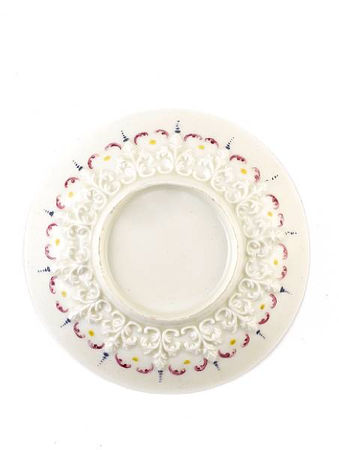An extremely rare and early Meissen saucer, circa 1713
An extremely rare and early Meissen saucer, circa 1713. photo Bonhams
With a band of acanthus leaves around the footrim, painted in the Funcke workshop in Dresden in green, blue, purple and yellow, with a crowned figure seated in a pavillion in front of a tree, flanked by flags, a chinoiserie figure by a censer in the foreground, the reverse with foliate scrolls and dots embellishing the moulded border of acanthus leaf scrolls around the footrim, 13.4cm diam. (minor flat chips to footrim) Estimate: £20,000 - 30,000 Unsold
Provenance: Probably from the collection of the Margravine Sibylla Augusta of Baden-Baden (1675-1733), Schloß Favorite, Rastatt;
Thence by descent to the Margraves and Grand Dukes of Baden, Grand Ducal Residence, Karlsruhe, and (from 1918), Neues Schloß, Baden-Baden; sold Sotheby's Baden-Baden, 7 October 1995, lot 1274;
Acquired in the above sale
Literature: Hoffmeister 1999, I, no. 8
Exhibited: Baden-Baden, Zähringer Museum, Neues Schloß, 1960-c.1990;
Hamburg, Museum für Kunst und Gewerbe, 1999-2009
The remaining three teabowls and saucers of this service - the only recorded examples of this early decoration - from the historic collections of the Margraves and Grand Dukes of Baden, are now in Schloss Favorite (Staatliche Schlösser und Gärten, inv. nos. G 7552-7553, 7590-7593 (published in Grimm / Wiese 1996 and Boltz 2000, ill. 61). The enthroned potentate in the pagoda is possibly based on a similar depiction, titled 'An Embassy', published in J. Stalker and G. Parker's A treatise on Japanning and Varnishing (1688), pl. 23.
A teabowl and saucer decorated in the same style and palette - probably by the same hand - but with a different scene and with applied flowering branches rather than acanthus leaves, is in the Hermitage Museum, St. Petersburg (Liackhova 2007. no. 16). Another of the type, with a third scene and applied acanthus leaves, is on loan to the Gardiner Museum, Toronto.
Claus Boltz has published the invoices of the Dresden enameller, Georg Funcke, which show that colours used on this saucer (purple, green, blue and yellow) were the first four colours used by Funcke in 1713 (Boltz 2000, op.cit., p. 143) .
Bonhams. The Hoffmeister Collection of Meissen Porcelain Part Two, 26 May 2010. New Bond Street www.bonhams.com

/https%3A%2F%2Fprofilepics.canalblog.com%2Fprofilepics%2F1%2F0%2F100183.jpg)




/http%3A%2F%2Fstorage.canalblog.com%2F63%2F85%2F119589%2F66261880_p.jpg)
/http%3A%2F%2Fstorage.canalblog.com%2F13%2F05%2F119589%2F66261326_p.jpg)
/http%3A%2F%2Fstorage.canalblog.com%2F43%2F98%2F577050%2F66241613_o.jpg)
/http%3A%2F%2Fstorage.canalblog.com%2F20%2F23%2F119589%2F66152064_p.jpg)